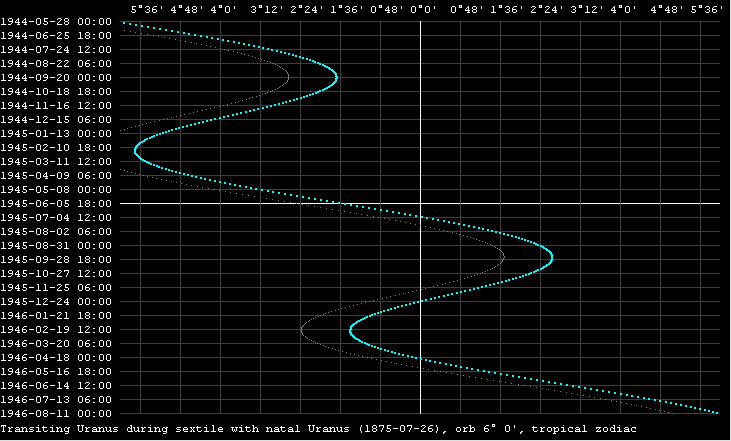Your Planetary Transits
How to Read Transit Tables |
| Back to Contents |

In the leftmost column is the type of transit (e.g., sextile), then there are three columns which correspond to the three orb values: outer, middle and inner. The date in the first of these three columns is the date at which the transit (relative to the outer orb value) forms. The dates in the second and third columns are the dates at which the transit, relative to the middle and inner orb values, form. It may happen that the two planets form an outer orb aspect but the aspect never reaches the middle orb value, in which case there are no dates given in the second and third of those three columns. This is the case for Jung's 6° Uranus-Uranus sextile beginning on September 4, 1943. In such a case the minimum difference from exact is given in the rightmost column (in this example, 5°57'). If the aspect becomes exact (0°0') then the middle column holds the date and time of this event (marked by an asterisk) and the rightmost column holds the time: GMT or some other timezone as selected.
The three columns following the middle column contain the dates at which the aspect first exceeds the three orb values (in order: inner, middle and outer). Again, the first, or the first and the second, of these may be blank if the aspect never became exact.
It may happen that (as in the case of Jung's 6° Uranus-Uranus sextile beginning on May 28, 1944, and lasting over 26 months) because of retrograde motion the transit does not proceed smoothly, but rather the difference from exactness decreases, then increases, then decreases, and so on. In such a case the dates shown do not always increase when read row-by-row, but must be read in chronological order as explained below:

The exactness of the sextile changes from 6° at its start on May 28, 1944, through 4° on July 2, through 2° on August 21. The sextile does not become exact, instead reaching a minimum of 1°40' on September 18, 1944. At this point Uranus turns retrograde, and the difference from exactness increases to 2° on October 16, 1944, then 4° on December 10. It is headed toward 6° but then Uranus turns forward again and the sextile heads back in the direction of exactness, becoming 4° on April 21, 1945. This is the first date on the second line above. The sextile becomes exact on July 1, 1945, then becomes less exact, reaching 2° on August 14. It continues toward 4° but does not reach it, since Uranus becomes retrograde, and forms a new 2° sextile on November 2, 1945 (this is the first date on the third line). It continues in its retrograde motion to an exact sextile on December 22, 1945. Before emerging from this 2° sextile Uranus again turns forward and forms an exact sextile once more, on April 19, 1946 (the first, and only, date on the fourth line). The sextile then emerges from 2° on May 27, 1946, reaches 4° on June 30, and finally the 6° sextile ends on August 10, 1946.
The progress of this transit is made clear in the following graphic, produced using the Planetary Aspects and Transits software (the blue line shows the transit when the tropical zodiac is used, the gray line shows it when the sidereal zodiac is used).

| Next: Planetary Returns for Specific Events | |
| Your Planetary Transits | Home Page |